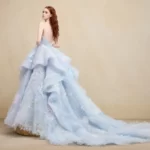 A veil seems to be a simple accessory, but it can complete and transform your entire look.
A veil seems to be a simple accessory, but it can complete and transform your entire look.
The lifting of the veil was often a part of ancient wedding rituals, symbolizing the groom taking possession of the wife, either as lover or as property, or the revealing of the bride by her parents to the groom for his approval.
In the last century, a bride’s veil was worn over the face during the ceremony and then lifted by the father of the bride or the groom at the end of the ceremony.
Today, a veil is a fashion accessory. Choose your gown first and then try various types and lengths of veil that best complement your gown.
Veil Options
Birdcage or Flyaway: Short, covering the hair and top of the face
Blusher or Fountain: Short, but completely covers the face and head
Elbow or Waterfall: Relatively short, to below the shoulders
Fingertip or Waltz: To below the hips
Floor length: Just touching the floor
Chapel: Has a short train
Cathedral: Very full with a long train
Consider the Site
If you are being married in a large church and having a formal wedding, you may want to consider having a cathedral veil. However, if you are being married outdoors, consider the wind. A shorter veil is less troublesome.
Consider the Gown
If possible, try on veils while wearing your dress. Your veil should never compete with your dress but should compliment the style. Don’t let it take centre stage.
Consider your Hair Style
Most veils work well when hair is worn down. However, if hair is pulled back in an updo, choose a very sheer veil so the hair can be seen. The veil can be attached to the hair with flowers, clips, jewellery or a tiara. Often, a bride will remove the veil at the reception and replace just the tiara which works nicely on its own.
Originally published in Today’s Bride magazine, Fall/Winter 2017.







